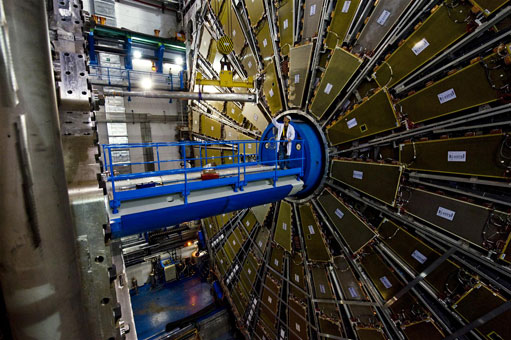
ATLAS e-News
23 February 2011
Bringing up the pressure
28 October 2008

Installation of the beam pipe in June
No doubt that opening the ATLAS detector is a delicate operation. But equally delicate are some of the preparatory procedures that need to be undertaken every time the detector is to be open. One of these essential operations is to bring the beam pipe up to atmospheric pressure, so that the various sub-detectors parts that need to be moved can be manipulated without damaging the fragile beam pipe.
In the on-going work to open the ATLAS detector, the beam pipe will remain at the same position throughout the whole operation. The vacuum chamber is not being moved because if just one flange is opened, then the whole system would need to be re-commissioned and tested, which is a lengthy procedure.
“When you have something as optimised in design as the beam pipe, you cannot start sliding surrounding pieces freely,” explain Ray Veness, project leader of the CERN experimental vacuum team. “And when the beam pipe is under vacuum, it is particularly fragile; it can collapse, or it can be easily damaged. That is why it has to be let up to atmospheric pressure.”
And this is what the CERN vacuum team did the week between the 12th -17th October. The vacuum experts, lead by Adriana Rossi, designed a special gas injection system, which injected neon inside the beam pipe to vent it and bring the pressure up to atmospheric value.
This is not an easy task to carry out in such a complex vacuum system as the one in ATLAS; one of its particularities is that the inner walls of the beam pipe are coated with a material known as NEG (Non-Evaporable Getter) pump, which is used to maintain the ultra-high vacuum required for operation.
Because the NEG is such a good pump, it puts some constraints when choosing the gas that engineers will use to fill up the beam pipe.“You don’t want to vent the beam pipe to air, because it would be immediately pumped by the NEG and the surface saturated,” explains Ray. “So we have to let the beam pipe up to atmospheric pressure with something that is not absorbed by NEG, such as neon.”
Neon gas is the perfect choice, as it does not react with the NEG pump. “Among noble gases, we don’t want to use helium, because it would interfere with leak detections, and other noble gases are too exotic, and too expensive. Neon is reasonably available, with a relatively low atomic mass, so a small residual amount does not interfere with ATLAS physics.”
The other critical point of the process is that the cleanliness of commercial neon is not enough for directly putting it into the beam pipe as impurities would also be pumped by the sensitive NEG pump. So, the vacuum team had to develop a special gas purification system: “The quality of the gases you buy is in the range of ppm and we need a gas with a purity in the ppb range,” explains Ray. “Adriana had to design a special gas purifying system for the LHC experiments in-house at CERN.”
All in all, it is a very delicate operation. “You have to make sure that you do every step properly, ” says Ray. “Opening the wrong valve at the wrong moment could leave you needing to re-commission the whole ATLAS vacuum sector.” The whole process finished on Friday 17th and left the ATLAS detector ready to be safely opened.

Cristina JimenezATLAS e-News |